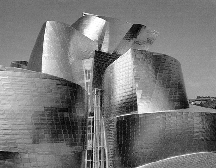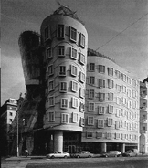|
|
||||||
|
Citation - 1998 RAIC Gold Medal - Regina, Saskatchewan, Canada
|
||||||
|
by Raymond Moriyama When I was presented the RAIC Gold Medal in Montreal last year, I considered it a great honour to have my professional and personal friend, a member of the RAIC executive, Christina Perks, present my citation and to have my work recognized by my peers in Canada. Today, the benefits from receiving last year's award continue, as I have been asked to present the citation for this year's recipient, Mr. Frank Gehry. But unlike previous Gold Medal citations, which are often delivered by life-long friends, I honestly must admit that I have never met the man before today. Considering, however, the huge amount of International attention he and his wonderful Guggenheim Museum in Bilbao have received in the past year, I must say, somehow, I do feel like I know him well. Nevertheless, I had help in researching Frank Gehry from many people, especially Donald Wiedman of RAIC.
My first close encounter with Frank came when our son, Jason, an architectural student then at SCIArc, took me to the Norton House in Venice, California, and I saw it from Oceanfront Boardwalk. Later my wife and I spent several days in the Chiat/Day Building -- the "one with the binoculars" -- when Jason and his graduating class were receiving critiques for their final design thesis. I thought it very appropriate that these activities take place in Frank's architecture. Since then, I have enjoyed getting to know the man by visiting other Gehry buildings. The most recent is the "Pariser Platz 3" under construction adjacent to the Brandenburg Gate in Berlin.
My next Gehry pilgrimage -- another special request from Sachi -- again for her birthday this coming October -- will take me to see the Guggenheim in Bilbao. Which allows me to take full advantage of my role here today to ask: "Mr. Gehry, just curious, has your wife ever asked you to take her on her birthday to see other architects' work or -- other hockey teams?" So, who is this ex-patriot Frank Gehry, that we all know so much about but have never met? Well, Frank was born in Toronto in 1929, and moved with his parents to California in 1947. It was in Toronto where Frank began to interact with the objects of Kensington Market which would later have such profound influence on his work. As a Canadian, I am proud to know that the fish, glass and chain link fence of our own Toronto are now displayed on the world stage through the work of Frank Gehry. I'm glad they were not what I used to encounter everyday in Kensington Market area where I lived while attending University of Toronto -- freshly beheaded chickens and soggy bagels. It is also interesting to ponder, as the article in our Festival Magazine asks: "What would Canadian architecture look like had Frank never left, had he stayed here to build, and thus had a larger influence over our cities' architects and architectural landscapes. When I ponder this "imponderable", three images come to mind: 1) I see the CN Tower in Toronto with a fruit basket for an observation deck or a fish in full flight. 2) I imagine a young Arthur Erickson at his design table pondering very seriously how he could convince his clients to build Robson Square in Vancouver, not out of concrete, but out of BC plywood! and 3) I envision Montreal's Big O - not looking any different, but -- like Bilbao -- I see its structural steel being the only part of the 1976 Summer Olympics to come in under budget! Since his critically acclaimed renovation of his own bungalow in Santa Monica and his first wide-spread international attention from his "Easy Edges" laminated cardboard furniture series, Gehry has remained distinctly Canadian, by humbly accepting his role as a premier American Architect. He received his Bachelor of Architecture degree from the University of Southern California, and studied City Planning at Harvard University's Graduate School of Design. During his years as a young architect, Mr. Gehry worked with Victor Gruen and Pereira & Luchman in Los Angeles, and with Andre Remondet in Paris. In 1962, Frank established his own firm, Frank O. Gehry and Associates. The three Principals of the firm Frank, Jim Glymph and Randy Jefferson, work as a team in the development of all projects undertaken, Jim and Randy complimenting Frank's work as Design Principal with their extensive experience in project management and the development of technical systems. At the heart of the firm's approach to design is a process which has developed over many years, in which the client is brought fully into the design process as part of the design team, making the design a true working collaboration between firm and client. Actual building materials and large scale mock-ups are employed to promote understanding of the design. The models explore both the functional and sculptural aspects of the project in a medium understood by designers and lay people alike. This is a very sound practice that we architects could all learn from. The combination of model building and mock-up capabilities, materials research, and the application of advanced computer systems and construction techniques allows Frank Gehry & Associates to develop designs, in a rational process, that reach beyond the traditional limits of architecture. This "reaching beyond traditional limits of architecture" has brought Frank worldwide recognition and scores of awards. He has so many that if I were to recite them all this citation will go far beyond a reasonable time frame. I will touch only on the highlights. They include the 1992 Imperiale Award in Architecture, an award given by the Japan Art Association for "outstanding contributions to the development, popularization, and progress of the arts", the l980 Pritzker Architecture Prize. In October, 1994, Mr. Gehry became the first recipient of the Lillian Gish Award for "lifetime contribution to the arts." And, recently, Frank was honoured in Austria where he received the first Friedrich Kiesler Prize. He was made a Fellow of the American Academy of Arts and Letters in 1987, a Fellow of the American Academy of Arts and Sciences in 1991. In 1994, he was bestowed with the title of "Academician" by the National Academy of Design. He has received numerous honourary doctoral degrees, including one from the Technical University of Nova Scotia. In 1982, 1985, 1987, 1988, and 1989, he held the Charlotte Davenport Professorship in Architecture at Yale University. He was elected to the College of Fellows of the American Institute Architects in 1974, and has received over one hundred national and regional A.I.A. Awards. Hallmarks of Frank Gehry's work are his inclusive approach, identified by a particular concern for the ways people move through - and live and work comfortably within - the spaces he has created, and an insistence that his buildings address the context and culture of their sites and host cities.
And on a personal note: Gehry's works have been placed on the top ten places the Moriyama family likes to visit when on vacation! We love his witty seriousness, the uncanny understanding of human nature, his earthiness and his generosity of spirit. Frank Gehry resides today in Santa Monica, California, with his wife Berta, and their two sons, Alejandro and Sam. The family lives in the same house discovered by Berta and controversially remodeled by Mr. Gehry. But I won't reveal to you the address. With truly Canadian humbleness, I doubt Mr. Gehry would appreciate the traffic or additional gun shots at his home like the two previous ones -- which Frank claims were not carried out, as rumours claim, by architects and architectural critics. Ladies and Gentlemen, it is my absolute pleasure to introduce to you, my esteemed colleague,-- or as they say in L.A. -- a "close and personal friend of mine" -- the 1998 recipient of the RAIC Gold Medal -- the world famous, Mr. Frank Owen Gehry. |
||||||

|
||||||
 Not to say that before this year my life was void of Frank Gehry -- impossible!
Not to say that before this year my life was void of Frank Gehry -- impossible!
 Frank, my wife, Sachi, loves your buildings. Last year for her birthday we flew to Prague, Czech Republic, to explore your National Netherland Building -- the one with twin towers, affectionately known locally as "Ginger and Fred". Sachi is a dancer and loved "Ginger", elegantly leaning back as if in a graceful, swirling waltz in a transparent ball gown. This leaning and pinching at "the waist", we were told, was done so the occupants in the neighbouring apartments could see the distant Prague Castle, high on the hill across the Vltava River. Very thoughtful! Being a non-dancer with two left feet, I did not relate to "Fred" as a dancer; but, Frank, I liked "Fred".
Frank, my wife, Sachi, loves your buildings. Last year for her birthday we flew to Prague, Czech Republic, to explore your National Netherland Building -- the one with twin towers, affectionately known locally as "Ginger and Fred". Sachi is a dancer and loved "Ginger", elegantly leaning back as if in a graceful, swirling waltz in a transparent ball gown. This leaning and pinching at "the waist", we were told, was done so the occupants in the neighbouring apartments could see the distant Prague Castle, high on the hill across the Vltava River. Very thoughtful! Being a non-dancer with two left feet, I did not relate to "Fred" as a dancer; but, Frank, I liked "Fred".
 From an aesthetic standpoint they have been placed in history among the most "profound and brilliant works of architecture of our time".
From an aesthetic standpoint they have been placed in history among the most "profound and brilliant works of architecture of our time".